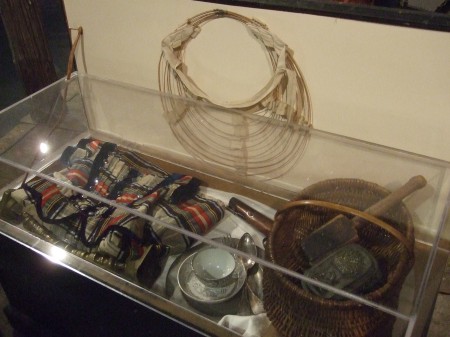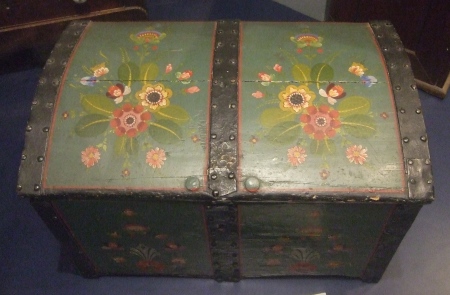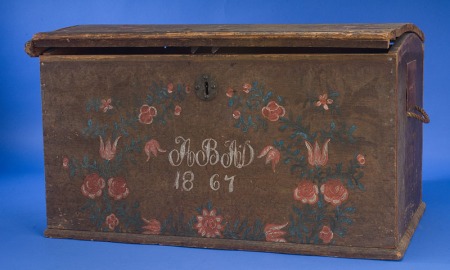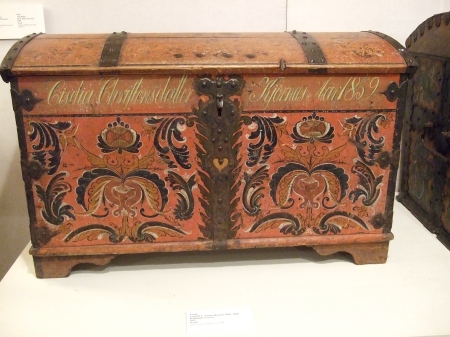A Settler’s Year: Pioneer Life Through the Seasons focuses primarily on newcomers’ experience after reaching their destination. But many of the European immigrants’ diaries, letters, and reminiscences included poignant descriptions of their journey from old world to new.
Museums and historic sites like Old World Wisconsin preserve not only the stories, but bits of the travelers’ surviving material culture. And there is, perhaps, no other object more closely tied to the immigrant experience than the immigrant trunk.
Some were plain, and purely functional.

This trunk was constructed of pine, with simple iron fittings, c. 1880. (Smithsonian National Museum of American History)

This one was used by a Dominican sister from France in 1880. (Smithsonian National Museum of American History.)

This plain wooden trunk has beautiful ironwork details. Some immigrants chose trunks with rounded lids, hoping it would keep them from being buried on the bottom of towering stacks of trunks packed in the hold. (Schulz Farm, Old World Wisconsin, Eagle, WI)
Many trunks were painted with the owner’s name.
Some had a bit of painted decoration…

Trunk used by Halvor Anderson Lovaas on his trip from Norway, 1860. (Wisconsin Historical Museum, Madison, WI)
And some, such as these Norwegian immigrant trunks, were exquisitely painted.

Detail on trunk visible in preceding photo. Painted by Ola Eriksen Tveitejorde, Voss, Norway. (Vesterheim Norwegian-American Museum, Deborah, IA)
Artistry aside, any immigrant trunk is valuable because it represents the people who struggled to fit their old lives within its confines. How many times did a family pack and repack it in the weeks leading up to departure? What was the most efficient way to pack?

This exhibit at Vesterheim Norwegian-American Museum suggests the difficult choices immigrants had to make. What would fit? What had to be left behind?
First must come the essentials: food for the journey, warm clothes, seeds, necessary tools. People didn’t always have accurate information about what was available in America, or how much it would cost.
And surely treasured mementos of home were squeezed in, too.

Many ale bowls (which inspired my first Chloe Ellefson mystery, Old World Murder) made their way from Old World to New. Since bowls like this one wouldn’t have been easy to pack, they must have been treasured keepsakes. (Artifacts in storage at Vesterheim Norwegian-American Museum)

This trunk, originally brought from Ireland, is shown with items both practical and, perhaps, “for best.” (Wisconsin Historical Museum, Madison, WI)
For the earliest immigrants, trunks served as furniture and storage in the New World.

The Schulz Farm at Old World Wisconsin depicts a family which had only been in the US for a few years, so furniture was relatively spartan and basic. A huge trunk provides storage and, perhaps, a place to leave a shawl or book if needed.
But in time, trunks often ended in attics or outbuildings, filled with old clothes or pressed into service as grain bins. Gorgeously painted trunks were once so common, I’m told, that even museums with a focus on immigration had to decline many offered donations.

This lovely trunk got a second life when Per Lysne, who many credit with the revival of rosemaling in the US, painted it in the 1930s or 1940s. (Wisconsin Historical Museum, Madison, WI)
Every trunk saved is a tangible reminder of the often anguished choices people made about what they might carry, what must be left behind.
Fortunately, hopes and dreams took up no space at all.
* * *
Want to see more trunks? Vesterheim has a fabulous collection of rosemaled trunks online.












